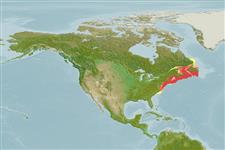Classification / Names
Common names from other countries
Main reference
Size / Weight / Age
Max length : 40.0 cm SL male/unsexed; (Ref. 7251); common length : 30.0 cm SL male/unsexed; (Ref. 7251); max. published weight: 200.00 g (Ref. 7251); max. reported age: 9 years (Ref. 72462)
Length at first maturity
Lm ?, range 11 - ? cm
Environment
Marine; freshwater; brackish; pelagic-neritic; anadromous (Ref. 51243); depth range 5 - 145 m (Ref. 4639), usually 56 - 110 m (Ref. 5951)
Climate / Range
Temperate, preferred 8°C (Ref. 107945); 55°N - 34°N, 93°W - 53°W
Distribution
North America: Atlantic coast from Red Bay, Labrador in Canada to South Carolina in USA. Native to Lake Ontario; introduced into other Great Lakes via Welland Canal (first taken in Lake Erie in 1931). Introduced elsewhere, including New River in West Virginia and Virginia, and upper Tennessee River system in Tennessee, USA.
Countries | FAO areas | Ecosystems | Occurrences | Introductions
Short description
Dorsal
spines
(total): 0;
Anal
spines: 0. Moderately compressed, belly with a distinct keel of scutes. Lower jaw rising steeply within mouth; minute teeth present at front of jaws (disappearing with age). Lower gill rakers increasing with age. A dark spot on shoulder. Distinguished from A. aestivalis by its silvery peritoneum; eye larger than snout length; back greyish green on capture.
IUCN Red List Status (Ref. 115185)
Threat to humans
Harmless
Human uses
Fisheries: commercial; bait: occasionally
Tools
Special reports
Download XML
Internet sources
Estimates of some properties based on models
Phylogenetic diversity index
PD50 = 0.5000 many relatives (e.g. carps) 0.5 - 2.0 few relatives (e.g. lungfishes)
Trophic Level
3.4 ±0.3 se; Based on diet studies.
Resilience
Medium, minimum population doubling time 1.4 - 4.4 years (K=0.2; tm=3.6; Fec=2,180)
Vulnerability
Low to moderate vulnerability (29 of 100)
Price category
